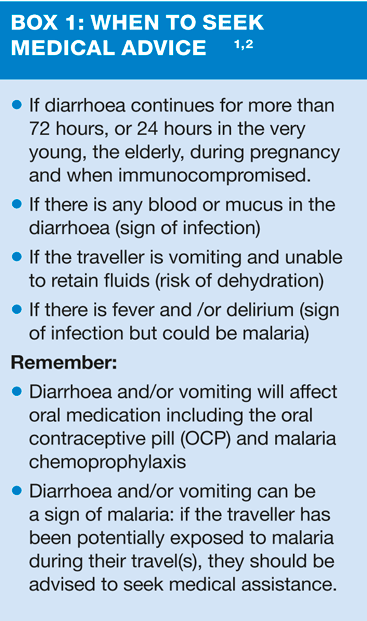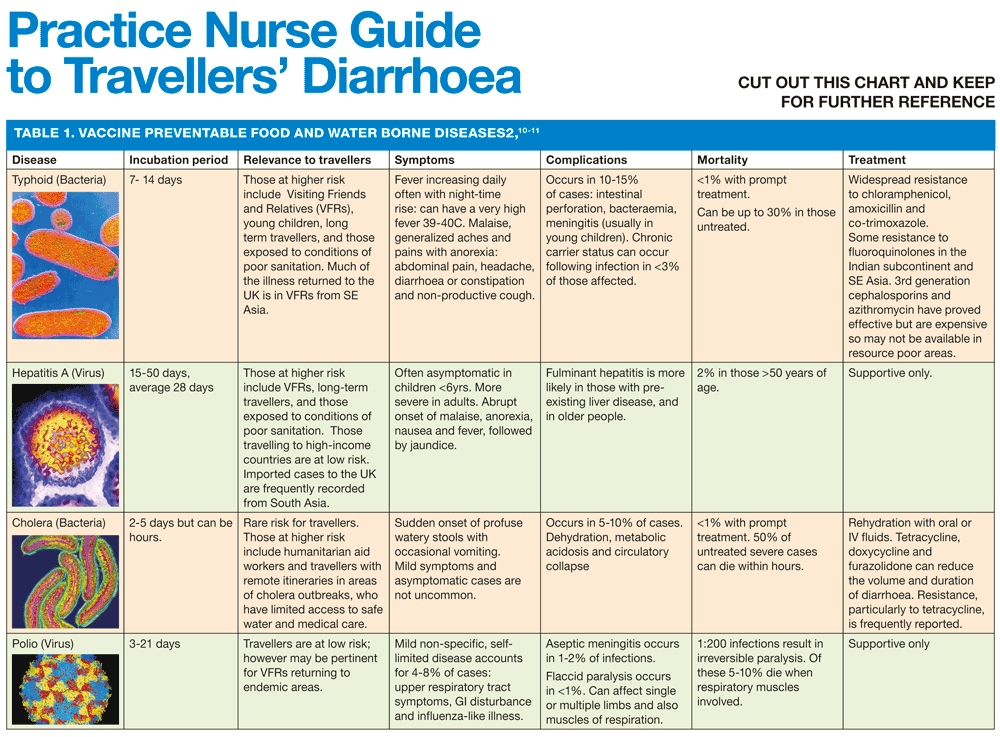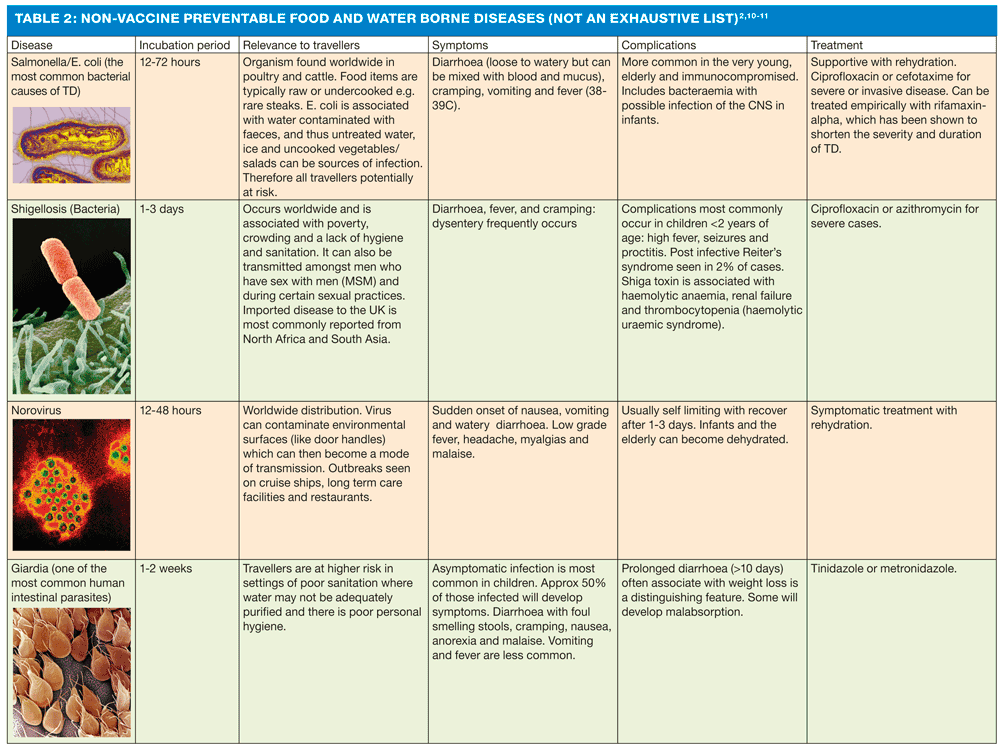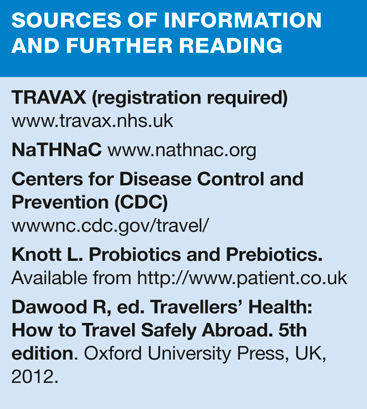Travellers' Diarrhoea
Margaret Umeed
Margaret Umeed
RGN MSc. MFTM (RCPSG) FQNIS
Specialist Nurse Practitioner, (General Practice) Glasgow
Travellers' Diarrhoea is the most common illness seen in travellers but it is caused by a wide variety of organisms, and only some forms are vaccine-preventable. This update includes a chart showing some of the most common causes of TD and how it should be treated
Travellers' Diarrhoea (TD) is estimated to affect between 20-60% of those travelling to low income, and therefore perceived as high risk, areas in Asia, the Middle East, Latin America and Africa.1 It is the most common illness seen in travellers and is caused by a variety of organisms such as Escherichia Coli (E coli), Salmonella, Shigella, Campylobacter, Enteric viruses, Norovirus and Rotavirus, Giardia and Cryptosporidium.2 Incubation periods range from a few hours to a few days, and is defined as 'the passage of at least three loose to watery stools in a 24 hour period, with or without other symptoms such as abdominal cramps, nausea and low grade fever'. TD typically occurs during the first week of travel and is usually self limiting, lasting 3-4 days, however symptoms can occasionally last longer than one month and can lead to irritable bowel syndrome (IBS).1
Because TD is so common, and because travel health advisors know that vaccines can only protect against four food and water borne diseases (see Table 1), advice relating to TD - the 'wash it, peel it or boil it' advice - is regularly regurgitated during every travel consultation. However, in the current climate of fluctuating vaccine stocks,3 there may be a point during the travel clinic where the travel advisor has to rationalise which traveller is more at risk of which disease, in order to use the stocks of vaccine available more appropriately. A knowledge of the diseases - risk of infection, incubation periods, signs and symptoms, possible mortality and complications and treatment options - is therefore crucial for the travel advisor to know, in order to convey that information to the traveller. Table 1 attempts to summarise such information and should be used in conjunction with the information found on the travel health websites for health care professionals listed in the Sources of Information.
Advice relating to TD should always include 'when to seek medical advice' and this is summarised in Box 1. Crucially, travel advisors should be aware why they issue the advice they do. What is the relevance of blood and mucus in the travellers' diarrhoea? What could be the significance of high fever? Table 2 summarises four common non-vaccine preventable pathogens that can cause TD. Not all TD will require treatment with an antibiotic, however a Cochrane meta analysis of antibiotic treatment for TD4 did find that antibiotic treatment reduced the duration of TD, but was associated with a higher incidence of side effects. The current recommendations for treatment can be found on the TRAVAX and NaTHNaC websites (see sources of information).
Can travel advisors suggest any other preventative measures in addition to the hygiene preventative measures often recommended? Enterotoxigenic E Coli (ETEC) is the most frequently isolated bacteria in travellers, accounting for approximately 60% of cases.5 The oral cholera vaccine (Dukoral) provides some protection for travellers, but is currently not licensed for use in this way in the UK and in general should not be used for this purpose.2
Probiotics are viable microorganisms with the ability to colonise the gut and compete with pathogenic bacteria.5 Research has provided inconclusive evidence that probiotics can significantly reduce the incidence or duration of TD when used prophylactically, although there are studies where probiotics have been used successfully to treat infectious, and antibiotic-associated diarrhoea, predominately in children.6 Finally, bismuth subsalicylate (BSS), in the form of Pepto-Bismol, has been shown to reduce the incidence of TD from 40% to 14%. BSS is not without side effects and should be avoided in those with aspirin allergy, renal insufficiency and gout, and by those taking anticoagulants, probenecid or methotrexate.7
Rifamaxin-alpha (Xifaxanta, Norgine) can be prescribed for uncomplicated, non-invasive TD in adults.8 This oral antibiotic remains active in the gastrointestinal tract with minimal systemic absorption (less than 1%), and travellers can opt to travel with a course for standby treatment should preventive measures fail.9
CONCLUSION
TD is a common and most often self-limiting illness that can, on occasion, lead to life-long problems with IBS or inflammatory bowel disease. Although travellers rely on vaccines to prevent TD, in reality, vaccines offer little protection against the most common pathogens responsible for TD. In the current climate of vaccine shortages, it is imperative the travel health advisor is aware of the risks to the traveller, and is able to advise the traveller appropriately in relation to risks and prevention, as well as immunisation.
REFERENCES
1. NaTHNaC. Travellers' Diarrhoea factsheet: updated November 2011. Available at: http://www.nathnac.org [Accessed: 7 October 2012]
2. Field VF, Ford L, Hill DR, eds. Health Information for Overseas Travel. National Travel Health Network and Centre, London, UK, 2010.
3. NaTHNaC. Supply of typhoid and hepatitis A/typhoid (combined) vaccines: UPDATE. Available at: http://www.nathnac.org [Accessed: 7 October 2012]
4. de Bruyn G, Hahn S, Borwick A. Antibiotic treatment for travellers' diarrhoea. Cochrane Database of Systemic Reviews, 2000. Available at: http://www.onlinelibrary.wiley.com [Accessed: 5 October 2012]
5. Wagner A, Wiedermann U. Travellers' Diarrhoea - pros and cons of different prophylactic measures. The Middle European Journal of Medicine. 2009:121:13-18.
6. Sazawal S, Hiremath G, Dhingra U, Mlaik P, Deb S, Black RE. Efficacy of Probiotics in prevention of acute diarrhoea: a meta analaysis of masked, randomised, placebo controlled trials. Lancet Infectious Disease 2006:6:374-82.
7. Connor BA. Chapter 2: The pre-travel consultation: self treatable conditions. Travelers' Diarrhea. Center for Diseases Control and Prevention. Available at: http://wwwnc.cdc.gov/travel/yellowbook/2012 [Accessed: 5 October 2012]
8. Xifaxanta (rifaximin) Summary of Product Characteristics. Available at www.medicines.org.uk
9. Chiodini J. Travel Health Update. Practice Nurse (23 March) 2012;42:29
10. Gill G and Beeching N, eds. Lecture Notes in Tropical Medicine. 6th edition. Wiley Blackwell, UK, 2009.
11. Royal Pharmaceutical Society and BMJ Group. British National Formulary. London, UK, March 2012.
Related articles
View all Articles



